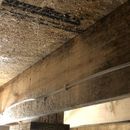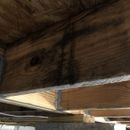New construction – mold issues
I’m building a new energy efficient home in Zone 4A, and we’re having some serious mold issues in the crawlspace. The framers are a couple of months behind due to weather and crew issues. We don’t have a roof yet, and everything is staying wet. We used precast walls for a conditioned crawlspace, so there is currently no ventilation other than the crawl space door.
How concerned should I be about the mold at this stage in the build? Is there something I could do to slow the mold growth? What should I do to clean it up once we’re in the dry? We’re targeting a 1 ACH50, so any mold sticking around would not be good.
GBA Detail Library
A collection of one thousand construction details organized by climate and house part











Replies
Hi Cody.
Your situation is unfortunate. If your build is not dried in and getting towards conditioned, then it is basically outside at this point, and stopping the mold growth is not going to be easy. As soon as you are dried in, you'll want to start running dehumidification, as even then the construction process is going to keep introducing moisture for some time, even once the house is occupied. Once you have humidity and temperature under control, mold will not continue to grow. There are a number of different ways people approach cleaning up mold, from borax , bleach, and peroxide to specific mold and mildew cleaners. Keep in mind that you may not get rid of the stains, but that doesn't mean the mold is still alive.
Bleach is terrible for treating mold! I know it's too late for this person but I just had to set this straight for the record. It's mostly water, which feeds the mold. It doesn't get into the porous material where the roots are. And it causes the mold to release more mycotoxins.
Qofmiwok - if bleach is bad, what are you recommending, and why?
Bleach and water can get into the porous material if you add in a surfactant (fancy word for soap). Cheap dishwashing soap mixed in with the bleach and water does a good job and will leave the wood looking brand new.
Yes, I know that mold needs water but so does any liquid that you would use to kill the mold. There are professionally applied methods like soda blasting that will remove surface mold without water, but they're expensive, not always locally available, and I don't know how effective they are at killing mold beyond the surface layer.
That’s a rather lot of mold for new construction. I’d bleach those moldy areas once you have enough of the structure up to keep the weather out. You could also try hiring a remediation contractor but they tend to be expensive, although you might get a better deal on a project like this that isn’t occupied yet.
I’d run a box fan continuously circulating air through that crawl space area to help keep the moisture level under control. Rig the fan so that it draws air through the entire crawlspace, either blowing in or out on the end opposite the vents, or as close to that as you can manage. The goal is to keep the air circulating through the entire space so that there are no stagnant pockets of moist air where the mold can grow.
Don’t tarp anything yet as that will make things worse. You might be able to tent things though — have your framers make some quick A frame supports and use them to hold some tarps up like a temporary roof, just make sure the ends are open so that air can circulate. The goal is to keep rain off the wood structure so that the fan can keep things from getting overly damp.
Bill
You need a high-quality WRB on the outside to shield water intrusion, but also one that allows for drying. Look at 475 Building Products for Mento Plus or Solitex Adhero. https://foursevenfive.com/ You definitely should be installing your interior vapor retarder at this point in your framing stage. Staple Mento to the underside of the crawlspace joists and tape all seams with TESCON VANA.
Thanks for the advice! As soon as we get through the upcoming 8 day long rain streak, I think I'll cut a hole in the floor on the opposite side of the house of the crawl space door and put a heavy-duty fan there to get some air moving to dry things out. Once the roof is on (but not windows/doors), I'll bleach everything with a garden sprayer. Our HVAC strategy includes a whole-house dehumidifier, so that should help a lot.
Sam, we're doing a conditioned crawlspace (concrete floor, insulated pre-cast walls) so we shouldn't need anything on floor joists, right? Our exterior walls are SIPs with ZIP sheathing on the exterior.
Hi Cody.
Sounds like a good plan. I think Bills advice to get some air flowing is a good one to try. And again, get dehumidification started as soon as possible.
Cody, the ventilation will help a lot, as well as your HVAC plans to run a whole-house dehumidifier. Will the whole-house dehumidifier have a duct running to the crawlspace?
Unless your concrete is completely done curing and completely sealed off, I think you will still have a bit of humidity in the crawlspace. That humidity will condense around your floor joists and OSB and cause mold issues. I would definitely take a little time (after drying and a light bleach or peroxide spraying - Cedar Wash is great as it won't over-dry your wood) to insulate between the floor joists over the crawlspace with Roxul and then stretch an exterior air-tight vapor permeable membrane (Solitex Mento) across the insulation and joists to completely protect that area. All seams and penetrations taped or gasketed with Tescon Vana and Roflex gaskets. You don't want to take shortcuts here. Good luck with your build!
Sam,
I don't understand why you are suggesting insulating the floor between a conditioned crawlspace and the house above?
How will it be conditioned? Heated? Air conditioned? Just seemed like it was moist there and possibly cold.
A conditioned crawlspace means it will be included in the heated and ventilated envelope of the house. It's cold there now because the project is still at the framing stage.
If you ventilate well (with a fan), you can only get close to the outdoor dew point. If you close the crawlspace door, heat and dehumidify (even with a portable unit), you can get much drier.
Look into applying Bora-Care with Mold-Care.
Since this post came back to life, I thought I'd leave an update.
We ended up cutting a hole in the floor on the opposite side of the house of the crawlspace door and placing a fan to push air through the crawl space. As soon as the roof was on, I closed it up and ran a dehumidifier 24/7. Once it dried out to about 50% humidity, I treated with Bora-Care with Mold-Care. Then a week later I fogged it with Lemocide and then Concrobium. Now we have HVACD running to condition the space.
The mold appears to be gone (or at least it isn't hanging from the joists anymore - stains are still there). There's a little bit of a musty smell with the dehumidifier starts pulling air from down there, but hopefully that will clear with time.